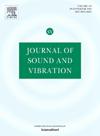利用贴片传递函数耦合声波黑洞到谐振腔
IF 4.3
2区 工程技术
Q1 ACOUSTICS
引用次数: 0
摘要
声波黑洞(SBHs)通常由一个半径递减的同心圆波导组成,这些同心圆被空腔隔开,这些空腔减慢入射声波的速度,消散它们的能量,并引起最小的反射。虽然在SBH仿真方法、性能分析和设计优化方面有很多工作,但没有人考虑过SBH与其他系统的交互作用。本文的目的是通过考虑SBH与谐振腔的连接以及确定SBH对腔内声压场的影响来开始探讨这一点。由于这是一个复杂的问题,首先提出采用patch传递函数(PTF)子结构方法来模拟耦合系统的行为。在对整个耦合系统进行有限元仿真验证PTF后,利用PTF进行参数化分析,评估单轴铰的位置和数量对腔内平均二次压力的影响。虽然sbh通常用于管道中的中高频降压,但研究表明,通过适当的设计,它们可以非常有效地消散腔内的低频压力峰值,具有室内声学应用等潜力。本文章由计算机程序翻译,如有差异,请以英文原文为准。
Coupling sonic black holes to a resonant cavity using patch transfer functions
Sonic black holes (SBHs) typically consist of a waveguide with concentric rings of decreasing radius separated by cavities that slow down incident sound waves, dissipate their energy, and cause minimal reflection. Although there are many works on SBH simulation methods, performance analysis, and design optimization, no one has considered the interaction of SBHs with other systems. The purpose of this paper is to begin to explore this point by considering the connection of an SBH to a resonant cavity and determining the effects the SBH has on the internal acoustic pressure field of the cavity. Since this is a complex problem, it is first proposed to resort to the patch transfer function (PTF) substructuring method to simulate the behavior of the coupled system. After validating the PTF with finite element simulations (FEM) of the entire coupled system, the PTF is used to perform parametric analyses to evaluate the influence of the position and the number of SBHs on the cavity mean quadratic pressure. Although SBHs are typically intended for medium and high frequency pressure reduction in ducts, it is shown that with proper design they can be very effective in dissipating low frequency pressure peaks within the cavity, with potential for room acoustics applications, among others.
求助全文
通过发布文献求助,成功后即可免费获取论文全文。
去求助
来源期刊

Journal of Sound and Vibration
工程技术-工程:机械
CiteScore
9.10
自引率
10.60%
发文量
551
审稿时长
69 days
期刊介绍:
The Journal of Sound and Vibration (JSV) is an independent journal devoted to the prompt publication of original papers, both theoretical and experimental, that provide new information on any aspect of sound or vibration. There is an emphasis on fundamental work that has potential for practical application.
JSV was founded and operates on the premise that the subject of sound and vibration requires a journal that publishes papers of a high technical standard across the various subdisciplines, thus facilitating awareness of techniques and discoveries in one area that may be applicable in others.
 求助内容:
求助内容: 应助结果提醒方式:
应助结果提醒方式:


